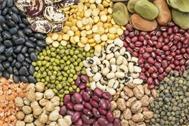3. Сельскохозяйственные машины широко используются для уборки зерновых.
4. Среди зерновых культур наиболее важными и наиболее широко выращиваемыми являются пшеница, кукуруза и рис.
5. Сахарная свекла – важнейшая корневая культура, возделываемая для получения сахара и на корм скоту.
6. Зерновые бобовые очень важны, так как, выращивая их, можно решить три главные задачи: увеличение производства зерна, увеличение растительного белка и улучшение почвенного плодородия.
7. Как листья, так и стебли люцерны используются на корм скоту.

15. Replace Russian words in brackets by their English equivalents:
1. The problem of the (борьба) of pests and diseases is a very important one in agriculture.
2. The (вегетационный период) of spring wheat is from 75 to 115 days.
3. Corn requires a long and (безморозный) period for its good growth and development.
4. The (содержание белка) in legumes is high.
5. Soil fertility may be increased by ploughing under (растительные остатки) of legumes grown.
6. Crops have either (мочковатый) or (стержневой) roots.
7. Our farm has a great (опыт) in growing soybeans.
8. This crop produces high yields only (в благоприятных условиях).
9. Legume crops are often grown as (культуры на зеленое удобрение).
10. Cereals are highly valued (во всем мире).
16. Identify the part of speech for the words in bold. Translate the sentences orally.
1. We value these crops for their fiber.
2. The value of cereals is known to all people.
3. People use the seeds of peas for food.
4. The agronomist spoke about this new field crop and its use in food industry.
5. We worked in the field yesterday.
6. Rye yields well under cool conditions.
7. Rye yields are usually high under cool conditions.
8. Yield increases can be obtained by growing improved varieties.
9. Our farm increases soil fertility by applying fertilizers and growing legumes.
10. Agronomists group field crops according to their use.
11. Corn has many uses.
12. Next summer our group will work on the farm "Zarya".

17. Answer the following questions to text A:
1. What is the principle of classifying field crops agronomically?
2. What crops have several uses?
3. How can corn be used?
4. Into what groups are field crops classified agronomically?
5. What is a cereal?
6. Why are large-seeded legumes so important for man?
7. Are root crops annuals or biennials?
8. When do biennial crops produce seed?
9. What is a forage crops?
10. How long can a forage crop grow?
11. What is the most important tuber crop?
12. How can fiber crops be used?
18. Scan text B and say what crops is mentioned in it.








